
Resources
-
09/21/2018
U.S. Trade Representative Now Accepting Requests for Product Exclusions from New Chinese Import Tariff
Client Alert
Written by: Henry T. Chou and Quinn Zhao
On September 17, 2018, President Trump announced that a 10% tariff on $200 billion worth of Chinese imports would take effect on September 24, 2018, with such duties set to rise to 25% on January 1, 2019. Approximately 300 of the 6,300 originally proposed categories of products (tariff lines) were removed as a result of public comments, leaving approximately 6,000 tariff lines subject to the new duties. Click here to view the updated Tariff List.
Despite the apparent inevitability of this new tariff, there is a procedure for U.S. stakeholders to apply for product exclusion. This past summer, the U.S. Trade Representative (USTR) released information about the process for applying for product exclusion. Under this process, U.S. stakeholders may request that particular products classified within a covered tariff classification be excluded from the additional duties. All exclusion requests must be received by October 9, 2018. Any exclusion granted by the USTR will be effective retroactively from the July 6, 2018 effective date of the additional duties, and extend for one year after the publication of the exclusion determination in the Federal Register.
As stated in the notice, any request for exclusion must include the following information:
- Identification of the particular product in terms of the physical characteristics (e.g., dimensions, material composition, or other characteristics) that distinguish it from five other products within the covered eight-digit subheading.
- The 10 digit subheading of the HTSUS most applicable to the particular product requested for exclusion.
- Requestors must provide the annual quantity and value of the Chinese-origin product that the requestor purchased in each of the last three years.
- Whether the particular product is available only from China. In addressing this factor, requestors should address specifically whether the particular product and/or a comparable product is available from sources in the United States and/or in third countries.
- Whether the imposition of additional duties on the particular product would cause severe economic harm to the requestor or other U.S. interests.
- Whether the particular product is strategically important or related to “Made in China 2025” or other Chinese industrial programs.
There is still time to act if a product that you import is subject to the impending tariff. Hill Wallack LLP stands ready to assist its clients in minimizing the effects of the tariff.
©2018 Hill Wallack LLP. All rights reserved. Please contact Hill Wallack for permission to reprint. Notice: The purpose of this Client Alert is to identify select developments that may be of interest to readers. The information contained herein is abridged and summarized from various sources, accuracy and completeness of which cannot be assured. This Client Alert should not be construed as legal advice or opinion, and is not a substitute for the advice of counsel.


